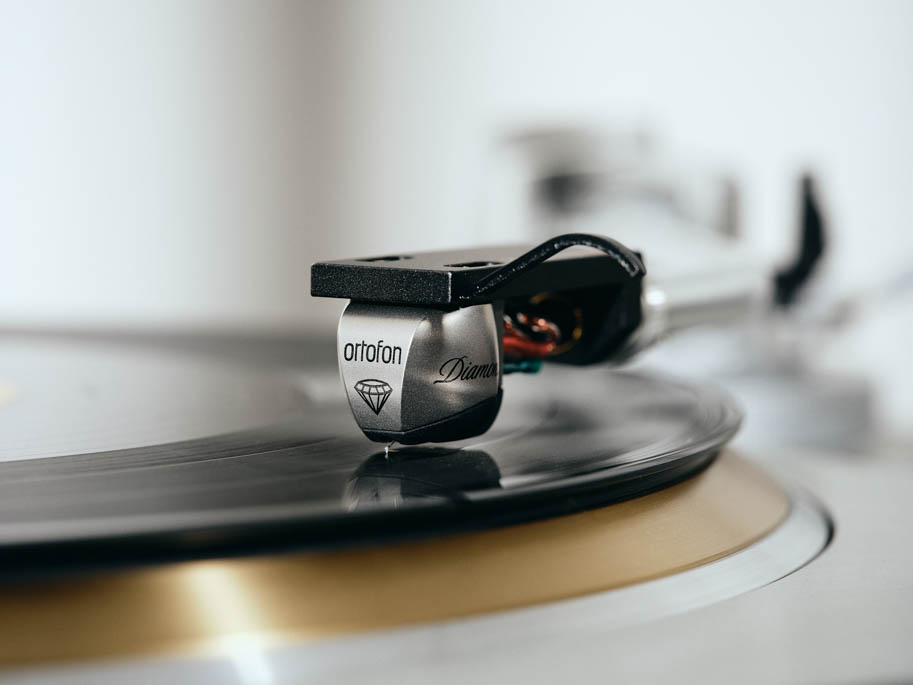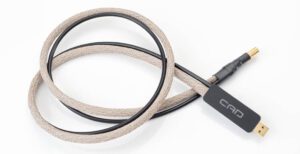
Put the name of this Ortofon cartridge into a search engine and you get a lot of references to its predecessor, the Anna MC Diamond. This evolved from the plain Anna but has now dropped that moniker to become the straight MC Diamond. Anna was a reference to opera singer Anna Netrebko; an artist who clearly made a big impression on Ortofon’s Leif Johansson, but latterly made the mistake of backing Putin when Russia attacked Ukraine last year. You can understand a famous Russian singer wanting to stay on the right side of that particular dictator but the latest Ortofon range topper no longer carries her name.
The MC Diamond is a distinctive cartridge in more ways than one. For a start, the body is made of titanium rather than more popular cartridge materials like aluminium and wood. In this instance, the titanium has been formed using selective laser melting, a technique which allows Ortofon to control the density of the metal and deliver higher internal damping than can be achieved with machining alone. Titanium is a lot denser and heavier than aluminium and favoured by another Danish company Ansuz who prefer its sonic character when used in isolation products and casework. A third example is in the counterweights on Rega’s top tonearms, there is more to this metal than most are aware.

What distinguishes this from preceding Diamond models is the suspension material which is made of a rubber compound that’s based on multi-wall carbon nano tubes; the first example of this ground breaking material being used in this way to our knowledge. The suspension is based around a heavy platinum disc that’s sandwiched between rubber absorbers with different properties in order to allow “exceptional tracking” with “perfect damping”. It’s safe to say that Ortofon has pushed out the proverbial boat with the MC Diamond.
Diamonds are Forever
The cartridge’s name derives from the solid diamond cantilever, virtually all decent cartridges have a diamond tip but very few go as far as to make the connection between tip, suspension and armature out of this extremely hard material.
The benefit is extremely high stiffness, way beyond that available with more popular materials in high end MCs such as boron. The drawback is cost and fragility, cartridges are always vulnerable things but the fact that Ortofon makes an easy to use stylus guard for the MC Diamond gives you some idea of just how easy it might be to damage this tiny jewel.
The tip that Ortofon has selected is called the Replicant 100 Diamond, which is not a reference to Blade Runner but a name chosen for a line contact shape that is narrow and long and “as close as possible to original cutting stylus”. The Replicant 100 stylus can be found on a number of Ortofon’s high-end MCs, but this example is the only one to enjoy the benefit of a diamond cantilever. The coils attached to the armature are made of ultra pure oxygen-free copper but there are apparently not very many of them as the output voltage is a low 0.2mV. This is not so low as to be an issue with phono preamplifiers in the same general ball park pricewise and you would be ill advised to use this MC with anything else. The alternative favoured by Johansson and many in Japan is to use a step-up transformer, which could be chosen to suit the low 6 Ohm internal impedance of this cartridge. Ortofon suggests a load impedance of over 10 Ohms, as few active phono preamplifiers offer less than 100 Ohms it’s easy to see that a step-up transformer might well produce the best results.
Heavy metal
The high 17.5g mass of this cartridge allied to a relatively high 2.6 gram tracking force mean that it’s suited to a high mass arm, fortunately these are more common than the increasingly rare low mass alternative, but in both the arms tried for this review an extra-heavy counterweight was required. Installation is relatively straightforward thanks to the decent stylus guard and threaded inserts in the top of the titanium body. The cartridge’s rounded body doesn’t aid alignment but the cantilever is long enough to be seen against a gauge without too much squinting.

I used the MC Diamond on an SME Model 20/3 with a Series V arm in the first instance and fired its output into a Tom Evans Groove+ SRX MkII phono stage with impedance set as low as it will go; an unconventional 112 Ohm. After a few sides to warm the Ortofon up many qualities started to become apparent, not least speed. I am used to fast cartridges (they are my preferred variety) but this is ‘next level’ fast, properly turn on a dime, quicksilver stuff. That diamond cantilever isn’t just there to hike up the price, it works incredibly well. Unlike many nimble cartridges the MC Diamond is also very solid and controlled in the bass, it goes down all the way and inspires a confidence that nothing is likely to deliver anything deeper. That’s a great feeling when combined with beautifully open and sparkly highs, tonal range is clearly a strong point and allows this MC to deliver acres of reverb whenever it’s present in the recording.
Tea up
Felix Laband’s ‘Whistling in Tongues’ (Dark Days Exit) produces a soundstage that is positively holographic with this cartridge, it’s not exactly a natural recording but nonetheless this South African artist puts some real acoustic magic in front of your ears when the groove is tracked with this degree of precision and absence of distortion. This three dimensional quality is apparent on a wide range of LPs thanks to the degree of detail resolution on offer, it puts Michael Franks in the room to a degree that is uncanny on his The Art of Tea album. The vintage and nature of the recording is abundantly clear but so is this plush production from 1975, it’s also pretty damn clear that the Larry Carlton, Wilton Felder, Joe Sample et al were at the top of their respective games at the time.
I was missing the sprightliness of my Rega P10 however so swapped the Ortofon over and hung the heaviest (titanium) counterweight I have rather close to the end of its stub to get the tracking force right. This turntable is not really designed for such meaty cartridges, Rega’s top MC weighs 6g, but the results were nonetheless superb.
I had a particularly good time with Melanie di Biasio’s album No Deal. This has black backgrounds to the voice and pared back instrumentation. Here the singer was placed front and centre in the room, the treatment of the vocal making it eerily present and intimate while the silence of the backdrop meant that all the fine details that usually blur into one another were resolved and defined to a remarkable degree. The track ‘With All My Love’ was particularly powerful, the sense of musicians being the room positivity visceral and the low pulse of the bass synth notes at the end so velvety and deep that you could take a bath in them.
Being a truly high resolution component the differences between recordings are obvious and there were some tracks on Stephen Stills’ eponymous album that sounded very grungy, it’s an old pressing and could perhaps be cleaner. However when ‘Black Queen’ came around the zing and vitality of the acoustic guitar was electrifying, quite how one track can sound so much better than the rest is very strange but is probably down to the relatively simple nature of the arrangement. It inspired me to put on Deja Vu (Crosby, Stills, Nash and Young) where the song ‘Almost Cut My Hair’ proved to be a lot more powerful and engaging than usual, the guitars again proving the highlight although Crosby’s voice was also excellent.
Ortofon have been refining the tech behind their finest moving coil cartridge for more than a few years now and the results fully warrant the effort involved. It’s hard to say what the nano tube suspension has added to the mix but this is a superb cartridge that extracts more detail from the groove than most. It’s high mass and low output require careful partnering for maximum thrill power but even in less than perfect systems the results are in another league. Give it the right turntable and amplification and I’ll warrant that it’s up there with the very best in the vinyl cosmos.
Technical specifications
- Type Low output moving coil phono cartridge
- Stylus/Cantilever Special polished Nude Ortofon Replicant 100 line contact, diamond cantilever
- Tracking Force 2.5g–2.8g (2.6g recommended)
- Load >10 Ohms
- Compliance 11 µm/mN
- Output (at 1 kHz @ 5cm/s) 0.2 mv
- Weight 17.5g (without stylus cover)
- Price £7,349
Manufacturer
Ortofon A/S
UK distributor
Henley Audio
+44 (0)1235 511 166
By Jason Kennedy
More articles from this authorRead Next From Review
See all
PrimaLuna EVO 100 phono preamplifier
- Apr 22, 2024

Reiki Audio SuperSwitch Master Pro + Servant Pro
- Mar 27, 2024

Melco Audio N1-S38 music server
- Mar 27, 2024











